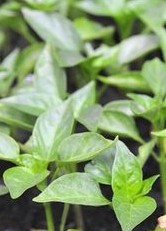 Hardening is the term used to describe the process of gradually exposing young seedlings grown indoors to the rigors of outdoor living in the garden. When plants are grown in doors they are living in a sheltered environment where the temperatures are relatively warm and even, there is no wind, the sunlight is filtered or indirect, and plant food has promoted growth. The cell structure of the plant develops accordingly and adapts the seedling to live in these “easy” conditions. Once the seedlings are in the garden they will have to contend with drying winds that can topple or break them, scorching sun, and cold temperatures. Seedlings need stronger tissues and protection from sun to stand up to these conditions and will develop these characteristics in about a couple of weeks under the right conditions.
Hardening is the term used to describe the process of gradually exposing young seedlings grown indoors to the rigors of outdoor living in the garden. When plants are grown in doors they are living in a sheltered environment where the temperatures are relatively warm and even, there is no wind, the sunlight is filtered or indirect, and plant food has promoted growth. The cell structure of the plant develops accordingly and adapts the seedling to live in these “easy” conditions. Once the seedlings are in the garden they will have to contend with drying winds that can topple or break them, scorching sun, and cold temperatures. Seedlings need stronger tissues and protection from sun to stand up to these conditions and will develop these characteristics in about a couple of weeks under the right conditions.
Hardening off involves two major phases, each involving about a week. The first involves preparatory procedures designed to toughen up the plants by slowing the metabolism so it builds stronger cell walls; the second is acclimating the plants to the outdoors. Begin about a week before you expect to move the plants outdoors when daytime temperatures should be at least 50 degrees.
Directions:
(Indoors-one week)
1. Reduce water.
2. Do not fertilize.
3. Keep in an area which is a few degrees cooler than normal for the seedlings.
(Outdoors-one week to ten days)
4. Set plants outside in a protected area for half day. A cold frame is ideal but a porch or enclosed area can be used.
5. The following days gradually leave the seedlings outdoors for a longer amount of time, making sure the soil is moist but not wet. Make sure the seedlings are receiving more direct sun every day.
6. By the end of a week the seedlings can be exposed to a full day of sun and wind, and a drop in nighttime temperatures.
7. Plant out in the garden.
The directions given here are specifically meant for seedlings but the same principles and procedures apply to houseplants that are moved outdoors for the summer.